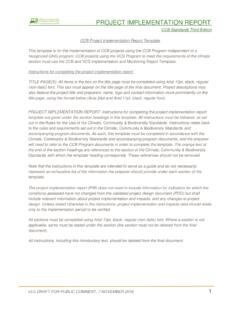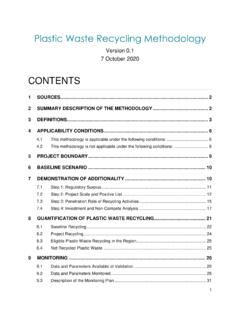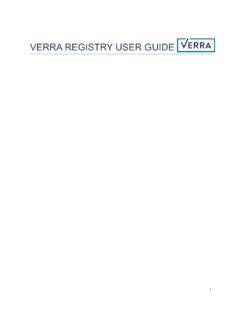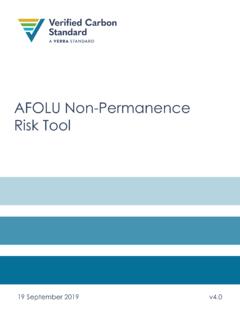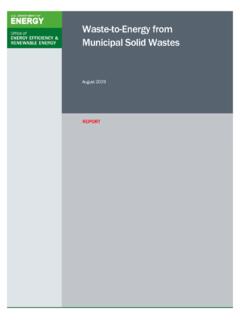Transcription of VCS Methodology - Verra
1 VCS Methodology VM0042. Methodology FOR IMPROVED. AGRICULTURAL LAND MANAGEMENT. Version 19 October 2020. Sectoral Scope 14. This Methodology was developed by Document prepared by TerraCarbon LLC. Authors: David Shoch and Erin Swails (TerraCarbon LLC). and Indigo Ag Indigo would like to acknowledge the many contributions by colleagues at Indigo Ag (in alphabetical order): Chris Black, Charlie Brummit, Nell Campbell, Max DuBuisson, Dan Harburg, Lauren Matosziuk, Melissa Motew, Guy Pinjuv, and Ed Smith. We would like to recognize the valuable input and guidance from Ken Newcombe at C-Quest Capital, as well as the many rounds of detailed review from the experts at Aster Global Environmental Services during the independent Methodology validation process. Finally, we thank our reviewers, especially the VCS Agricultural Land Management Working Group, whose comments and suggestions contributed to greatly increase the clarity and effectiveness of this Methodology . 2. VM0042, Version Sectoral Scope 14.
2 CONTENTS. 1 SOURCES .. 4. 2 SUMMARY DESCRIPTION OF THE Methodology .. 4. 3 DEFINITIONS .. 6. 4 APPLICABILITY CONDITIONS .. 7. 5 PROJECT BOUNDARY .. 9. 6 BASELINE SCENARIO .. 12. 7 ADDITIONALITY .. 14. 8 QUANTIFICATION OF GHG EMISSION REDUCTIONS AND REMOVALS .. 18. Summary .. 18. Baseline Emissions .. 20. Project Emissions .. 35. 38. Net GHG Emission Reductions and Removals .. 41. Uncertainty .. 48. Calculation of Verified Carbon Units .. 53. 9 MONITORING .. 53. Data and Parameters Available at Validation .. 55. Data and Parameters Monitored .. 74. Description of the Monitoring Plan .. 107. 10 REFERENCES .. 108. APPENDIX 1: NON-EXCLUSIVE LIST OF POTENTIAL IMPROVED ALM PRACTICES THAT. COULD CONSTITUTE THE PROJECT ACTIVITY .. 110. APPENDIX 2: RECOMMENDED PROCESS FOR ASSESSING WHETHER NEW PROJECT. ACTIVITY INSTANCES ARE COMMON PRACTICE .. 111. 3. VM0042, Version Sectoral Scope 14. 1 SOURCES. This Methodology is based on the following methodologies: VM0017 Adoption of Sustainable Agricultural Land Management VM0022 Quantifying N2O Emissions Reductions in Agricultural Crops through Nitrogen Fertilizer Rate Reduction VM0026 Sustainable Grassland Management This Methodology uses the latest versions of the following CDM tools: Estimation of carbon stocks and change in carbon stocks of trees and shrubs in A/R.
3 CDM project activities Simplified baseline and monitoring Methodology for small scale CDM afforestation and reforestation project activities implemented on lands other than wetlands Tool for testing significance of GHG emissions in A/R CDM project activities 2 SUMMARY DESCRIPTION OF THE. Methodology . This Agricultural Land Management (ALM) Methodology provides procedures to estimate the greenhouse gas (GHG) emission reductions and removals resulting from the adoption of improved agricultural land management practices focused on increasing soil organic carbon (SOC) storage. The Methodology quantifies net emissions of CO 2, CH4, and N2O from grower operations. The Methodology is compatible with regenerative agriculture. The baseline scenario assumes the continuation of pre-project agricultural management practices. For regions where an applicable performance benchmark has been approved by Verra1, that benchmark must be applied as the baseline scenario. Otherwise, for each sample unit within the project area ( , for each field), practices applied in the baseline scenario are determined applying a 3-year historic look-back period to produce an annual schedule of activities ( , tillage, planting, harvest, and fertilization events) to be repeated over the first baseline period.
4 Baseline emissions/stocks change are then modeled. The baseline scenario is 1 Such performance benchmarks currently (as of the date of publication) do not exist but may be developed and approved by Verra in the future. If following Quantification Approach 1 (Measure and Model), the performance benchmark developed and approved by Verra will need to include a defined modeled approach that allows for validating model performance and prediction error for use in the project domain, based on the requirements presented in the Model calibration, validation, and uncertainty guidance for the Methodology for improved agricultural land management document. 4. VM0042, Version Sectoral Scope 14. re-evaluated as required by the VCS Standard, and revised, if necessary, to reflect current agricultural production in the region. Additionality is demonstrated by the adoption, at the project start date, of one or more changes in pre-existing agricultural management practices. A practice change constitutes adoption of a new practice ( , adoption of one or more of the practices covered in the categories included in the applicability conditions as well as the illustrative improved agricultural land management practices listed in Appendix 1), cessation of a pre-existing practice ( , stop tillage or irrigation), adjustment to a pre-existing practice, or some combination.
5 Any quantitative adjustment ( , decrease in fertilizer application rate) must exceed 5% of the pre-existing value to demonstrate additionality. The Methodology provides a flexible approach to quantifying emission reductions and removals resulting from the adoption of improved agricultural land management practices under the following quantification approaches: Quantification Approach 1: Measure and Model an acceptable model is used to estimate GHG flux based on edaphic characteristics and actual agricultural practices implemented, measured initial SOC stocks, and climatic conditions in sample fields. Quantification Approach 2: Measure and Re-measure direct measurement is used to quantify changes in SOC stocks. This approach is relevant where models are unavailable or have not yet been validated or parameterized for a particular region, crop, or practice. Currently, Quantification Approach 2 cannot be used because a performance benchmark has not yet been developed. Quantification Approach 3: Calculation CO2 flux from fossil fuel combustion and N 2O.
6 And CH4 fluxes, excluding CH 4 flux from methanogenesis, are calculated following 2019. Refinement to the 2006 IPCC Guidelines for National Greenhouse Gas Inventories using equations contained in this Methodology . Quantification approach varies by emission/removal type. Approaches to quantification of contributing sources for CO2, CH4, and N2O are listed in Table 5. Monitoring is conducted for both the baseline and project scenarios. If an applicable performance benchmark is not available, emission/stock changes in the baseline scenario are modeled using Quantification Approach 1, partly on the basis of one or more monitored input variables ( , temperature, precipitation) or calculated using Quantification Approach 3 as detailed in Table 5. Table 1: Additionality and Crediting Baseline Methods Additionality and Crediting Method Additionality Project Method Crediting Baseline Project Method 5. VM0042, Version Sectoral Scope 14. 3 DEFINITIONS. In addition to the definitions set out in VCS document Program Definitions, the following definitions apply to this Methodology : Annual A plant species that within one year completes life cycle, reproduces, and dies.
7 Improved agricultural land management practice An agricultural practice yielding increased soil organic carbon storage or other climate benefit, involving a refinement to fertilizer application, water management/irrigation, tillage, residue management, crop planting and harvesting and/or grazing practices. N-fixing species Any plant species that associates with nitrogen-fixing microbes found within nodules formed on the roots, including but not limited to soybeans, alfalfa, and peas. Organic nitrogen fertilizer Any organic material containing nitrogen, including but not limited to animal manure, compost and sewage sludge. Perennial A plant species whose life cycle, reproduction and death extends across multiple years. Professional agronomist An individual with specialized knowledge, skill, education, experience, or training in crop and/or soil science. Project domain Set of conditions (including crop type, soil texture and climate) within which model application has been validated (see VMD0053 Model Calibration and Validation Guidance for the Methodology for Improved Agricultural Land Management ).
8 Sample point Sample location of undefined area. Sample unit Defined area that is selected for measurement and monitoring, such as a field or sample point. Sample unit and sample field are used interchangeably in the Methodology . Schedule of Activities Annual schedule of historical management/activity practices applied in the baseline scenario over the historic look-back period ( , tillage, planting, harvest, and fertilization events). These practices are based on data requirements of Box 1 repeated over the baseline period and apply 6. VM0042, Version Sectoral Scope 14. to relevant model input variables (see Tables 4 and 7) and parameters FFCbsl,j,i,t, Pbsl,l,i,t, Daysbsl,l,i,t, Mbsl,SF,i,t, Mbsl,OF,i,t, and MBg,bsl,i,t, etc. Synthetic nitrogen fertilizer Any fertilizer made by chemical synthesis (solid, liquid, gaseous) containing nitrogen (N). This may be a single nutrient fertilizer product (only including N), or any other synthetic fertilizer containing N, such as multi-nutrient fertilizers ( , N P K fertilizers) and enhanced- efficiency' N fertilizers ( , slow release, controlled release and stabilized N fertilizers).
9 Woody perennials Trees and shrubs having a life cycle lasting more than two years, not including cultivated annual species with lignified tissues, such as cotton or hemp. Year A time period t equal to the portion of the monitoring period contained within a single calendar year. May be less than 365 days. 4 APPLICABILITY CONDITIONS. This Methodology is global in scope and applies to a broad range of agricultural management project activities that increase soil organic carbon storage and/or decrease net emissions of CO2, CH4, and N2O from grower operations compared to the baseline scenario. This Methodology is applicable under the following conditions: 1. Projects must introduce or implement one or more new changes to pre-existing agricultural management practices which: Reduce fertilizer (organic or inorganic) application;. Improve water management/irrigation;. Reduce tillage/improve residue management;. Improve crop planting and harvesting ( , improved agroforestry, crop rotations, cover crops); and/or Improve grazing practices.
10 A change constitutes adoption of a new practice ( , adoption of one of the illustrative improved agricultural land management practices listed in Appendix 1), cessation of a pre-existing practice ( , stop tillage or irrigation) or adjustment to a pre-existing practice that is expected to reduce GHG emissions and/or increase GHG removals. Any quantitative adjustment ( , decrease in fertilizer application rate) must exceed 5% of the pre-existing value. See Appendix 1 for additional details on these practices. 7. VM0042, Version Sectoral Scope 14. 2. Project activities must be implemented on land that is either cropland or grassland at the project start date and remains cropland or grassland throughout the project crediting period ( , land use change is not eligible, including conversion from cropland to grassland and grassland to cropland). 3. The project area must not have been cleared of native ecosystems within the 10-year period prior to the project start date. 4. The project activity is not expected to result in a sustained reduction of greater than 5%2 in productivity, as demonstrated by peer-reviewed and/or published studies on the activity in the region or a comparable region.
